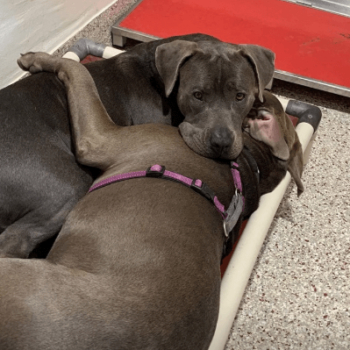This guest blog was written by Emmy-winning television journalist Nikki Reck, now Public Information Officer for Pima Animal Care Center in Tucson, AZ.
It’s a situation that many shelters understand – Agatha and Jukebox were a pair of big dogs that sat at Pima Animal Care Center for months, overlooked. We couldn’t figure out why. They were friendly, affectionate and playful. Then one day, someone snapped an adorable photo of them cuddling on this tiny little bed. That picture solved the problem of being overlooked.
Overnight, the post was shared by so many people. That turned into a request from a local television station looking to highlight their story. Then, the Dodo saw the posts and wanted to do their own interview. Their story resulted in over 15 media mentions. Shortly after, Agatha and Jukebox found the perfect home.
The fact that the post went viral was amazing, but you don’t have to go viral to get pets adopted. All you have to do is share their story with the media. We talk to so many folks in animal welfare who are terrified of speaking with the media. Don’t be! They are your biggest ally!
Here are the six most important things you can do to develop your relationship with the media:
1. Send news releases often! News releases are a way of highlighting something. It’s a direct line to the media! You can send them on events, hoarding cases, a need for fosters, full kennels, and more. Send news releases to all local outlets. If you don’t know where to begin, start by calling newsrooms and ask for assignment desk workers. They can often point you in the right direction.
2. Engage the reporters and create a relationship. If you encounter a reporter a couple of times or if you notice them re-posting stories involving your organization – text them! Offer them a look behind the scenes. They might see something that could turn into a story.
3. Recognize a good story when you see it. Find a great before and after that shows how a foster helped a sick kitten survive an illness and grow into a fluffy, playful pet or a dog that was lost for years but was reunited thanks to a microchip. Just look around. Even the pet with no notes has a story to tell. It’s your job to find it.
4. Post everything to your social media pages. News crews are short-staffed. News organizations are paying attention to those Facebook and Twitter accounts. Post those stories and include everything that a newspaper or tv station might need to run it on their own without sending someone to the shelter. A quick web mention about the need for fosters is better than no mention, right? If it is a good enough story, they will find a way to send a crew.
5. Know your material backward and forwards. Don’t be scared to answer questions. Practice with a trusted friend who will be honest with you. It’s ok to not know an answer. It’s not ok to say, “I don’t know.” Chances are someone you work with has the answer to the question, right? Tell the reporter, “Let me get back to you!” That shows that you can find the answer for them.
6. Clear your calendar. The most important thing when it comes to media is to BE AVAILABLE! If they are reaching out for a story, make it happen. They are working on very short deadlines, so make it turn around within the hour if possible. Remember, their audience isn’t your audience. There might be some crossover, but more than likely it’s a lot of new folks who otherwise might not see this story.
These tips will help news crews recognize that you are reliable and can get them what they need quickly. You’ll be their favorite person to work with!
Do you have questions for Nikki, or want to continue the conversation? We’ve started a thread on this blog in Maddie’s Pet Forum, where you can engage with her and continue the conversation!

